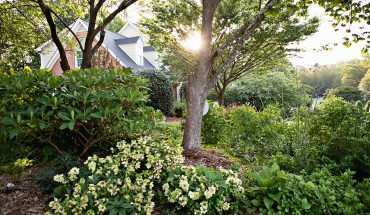
Sterling Boyd sits in his living room, where works of art from the 16th–20th centuries fill the walls.
by P. Gaye Tapp
photographs by Catherine Nguyen
An afternoon spent in Sterling Boyd’s company is a return to days of great elegance. The erudite octogenarian is ever gracious, schooled in the day when a gentleman took a lady’s wrap and stood when she entered a room. Boyd defies his years with élan.
Classical music provides the backdrop for his apartment, which is filled with paintings, etchings, textiles, and Boyd’s witty repartee. An academic, an aesthete, and a consummate collector, Boyd has a crystal-clear recollection of every piece of art he owns: its artist, subject, and acquisition.
He is an acknowledged Francophile, but his eclectic collection embraces many worlds and cultures. Boyd has Italian drawings from the 16th and 19th centuries, Rodman Wanamaker photogravure prints of Native Americans from the early 1900s, and British portraiture. The Empress Josephine is one of his most admired aesthetes, and his French antiques, objets de vertu, and art from the reign of Louis XVI to Napoleon unite his vast collection.
He has works on paper collected in Paris and London, and magnificent masks collected on his many trips to Mexico City and Cuernavaca. For Boyd, every object – every work of art – is a particular favorite, evoking a memory, time, and place in his life.
Though his apartment is just over 900 square feet, living on the grand scale is a way of life for Boyd. His North Raleigh apartment is reminiscent of a flat in Paris, which says something about its inhabitant and the absolute joie de vivre he radiates.

The apartment’s living room is formal yet comfortable. Graciously proportioned French chairs are covered in both a handsome stripe and a Scalamandre leopard print. A Chinese rug, circa 1950, adds a bold note to the room. On the far wall, African masks flank a large Chinese ancestral portrait. The French birdcage, circa 1900, is home to Boyd’s pet, Tweetie Bird.
Traveling the world
Originally from Little Rock, Ark., Boyd’s education took him to Sewanee, The University of the South, where he was lured into the world of art history; from there he spent a year in Belgium and returned to attend graduate school for art history. at Oberlin College.
He acquired his first painting on a trip to New York in 1958. Today that maritime Mediterranean scene, purchased at a gallery on 3rd Avenue, hangs alongside a modernist piece by American abstract painter Jules Olitski and a massive 19th century Chinese calligraphy scroll that extols the virtues of health and happiness.
His collection grew during a one-year stint at the Virginia Museum of Fine Arts in Richmond, where he worked as an assistant to the associate director, and during the years he spent earning a doctorate in Art History at Princeton.
He took advantage of the university’s close proximity to New York to collect portraits, architectural drawings, etchings, and whatever else caught his eye from the city’s galleries. From Princeton, he moved on to a teaching post at Washington and Lee and ultimately to Wake Forest as head of the university’s art department.
Through it all, Boyd’s art collection grew – as did the stories and enduring friendships made with fellow collectors, artists, and dealers.
Boyd finally found his way to Raleigh in the ’80s landing a job at the North Carolina Museum of Art at its original Morgan Street location with educational programs.
And then, after years in the worlds of art and academia, Boyd shifted his talents to interior design and decoration. He worked for Stuart Walston in Wilson and ultimately established his own independent design business in Raleigh. Today, Boyd is retired, but still consults with clients on art acquisitions and décor. His conversation drifts from classical music, to the arts, to politics, or to an upcoming auction.
Indeed, some of Boyd’s most prized pieces are his discoveries from auctions and dealers – the ones that came without a firm provenance. In the rarest of cases, if he’s stumped about the background of a particular piece, Boyd always has a friend – an expert in the field – to consult.
His boundless energy has him continuing in his eighth decade to collect, peruse auction catalogs, and drop in on Raleigh art dealer Otho Cozart to view his latest findings. Because a collection like Boyd’s defies completion.




